
India successfully test-fired the nuclear-capable Dhanush missile from a navy ship off the Odisha coast on February 24.
Dhanush was launched from a ship positioned near Paradip in the Bay of Bengal at around 10.52 am. It was part of the training exercises conducted by the Strategic Force Command (SFC) of the Indian defense forces.
The state-run Defence Research and Development Organisation's (DRDO) telemetry radar system placed near the Odisha coast monitored the Dhanush testing. And as per the officials, it was a complete success as it met all the mission objectives including take-off, flight performance and hitting the target with precision.
Earlier, test-firing of Dhanush was conducted on November 23, 2015, and it was a success too.
Here are six facts about Indian Navy's Dhanush missile:
- Dhanush (meaning, a bow in Sanskrit) is a variant of indigenously developed Prithvi surface-to-surface missile series, developed specifically for navy ships
- Dhanush is a Short-Range Ballistic Missile (SRBM) with single-stage liquid propellant and is capable of hitting targets in the range of 350 km to 750 km. For instance, if it is carrying a 1000kg warhead, it can hit target up to 350km from the launch station, while with up to 500kg and 250kg capacity, it can reach close to 500km and 750km, respectively.
- Dhanush warhead is capable of carrying Nuclear payload, submunitions, HE, Fuel Air Explosive (FAE) and chemicals as well
- Dhanush is predominantly used to hit enemy navy ships, but if required, depending on the location of the parent ship from the coast, it can be used to destroy land targets as well
- As far as the target hit precision is concerned, Dhanush is said to have Circular Error Probable (CEP) accuracy between 50m to 25m (as per CSIS Missile Defense Project)
- Dhanush measures 8.53m in length, 1m diameter and comes with a launch weight of 5,600kg.
Trivia:
Dhanush's parent variant, Prithvi is one of the five indigenous missiles developed by the Defence Research and Development Organisation (DRDO) under the Integrated Guided Missile Development Programme (IGMDP). Other four are Agni (Intermediate-range surface-to-surface missile), Trishul (Short-range low-level surface-to-air missile), Akash (Medium-range surface-to-air missile) and Nag (third generation anti-tank missile).















